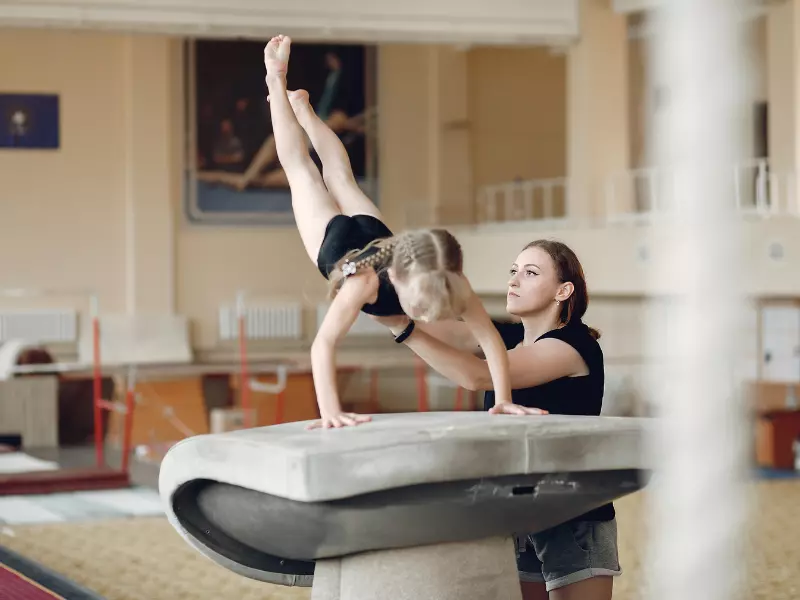Gymnastics, an ancient sport with a rich history, is composed of several disciplines that all require remarkable levels of strength, flexibility, and precision. Among these are Artistic Gymnastics and Rhythmic Gymnastics.
While they might share a common name, each one presents a unique set of challenges and requires a different set of skills. But the burning question remains: Comparing difficulty, how do Artistic and Rhythmic Gymnastics stack up against each other? We’ll dive into this topic and more in the article that follows. Let’s get flipping!
Contents
I. A Brief Overview: Artistic vs Rhythmic Gymnastics
Artistic Gymnastics and Rhythmic Gymnastics are two distinct disciplines within the sport of gymnastics. While they share similarities in terms of flexibility, strength, and coordination, they have different focuses and artistic expressions. Here’s a brief overview of each:
Artistic Gymnastics: An Expression of Power and Precision
Artistic gymnastics is a spectacle of raw strength, agility, and precise execution of complex maneuvers. It is the more popularly recognized form of gymnastics, showcasing athletes’ skills on different apparatus such as the vault, uneven bars (for women), parallel bars and high bars (for men), the balance beam (for women), and floor exercise for both genders.
Artistic gymnastics is focused more on acrobatics and strength maneuvers with a high emphasis on precision and control. It requires athletes to blend physical power with a precise sense of body mechanics and coordination.
Rhythmic Gymnastics: The Dance of Grace and Fluidity
Rhythmic gymnastics, on the other hand, is a mesmerizing blend of gymnastics, dance, and ballet, with athletes manipulating one of five apparatus: hoop, ball, clubs, ribbon, or rope. This discipline prioritizes flexibility, grace, and coordination, requiring gymnasts to incorporate dance-like movements seamlessly synchronized with their apparatus handling.
Rhythmic gymnasts perform both individually and in groups. The emphasis in this discipline is more on grace, dance, and equipment handling, rather than on acrobatics. The success of a rhythmic gymnastics routine lies not only in the technical execution of gymnastic elements but also in the artistic interpretation of music through expressive body movement.
II. Comparing Difficulty: Artistic vs Rhythmic Gymnastics
Comparing the difficulty levels between Artistic Gymnastics and Rhythmic Gymnastics can be challenging as both disciplines require different skill sets and have their unique complexities. However, it’s possible to discuss some key aspects related to difficulty in each discipline:
1) Physical Demands: Evaluating Strength and Flexibility
When comparing strength requirements, artistic gymnastics demands more power. This is particularly evident in the strength-intensive apparatus like the rings for men and the vault for both genders. Artistic gymnasts must generate considerable force in a brief period, often exhibiting explosive power.
Conversely, rhythmic gymnastics places greater emphasis on flexibility and coordination. Rhythmic gymnasts must exhibit an impressive range of motion and adaptability to perform elaborate movements with their apparatus while maintaining the rhythm of the music.
2) Apparatus Mastery: Artistic Versus Rhythmic
In artistic gymnastics, athletes must master multiple apparatus. The skill set required varies significantly, from the raw power needed for the vault, to the grace and balance for the beam, and the strength and coordination for the uneven bars.
Rhythmic gymnastics, however, requires gymnasts to master the manipulation of different apparatus while maintaining dance and body movements. The challenge lies not only in performing complicated maneuvers but also in the seamless integration of the apparatus into their routine.
3) The Role of Music: Rhythm in Motion
In rhythmic gymnastics, music is integral. Gymnasts must exhibit an innate sense of rhythm, timing their movements to the music’s beats. This aspect can increase the difficulty level, as rhythmic gymnasts must not only concentrate on their moves but also coordinate them with the music.
In contrast, music in artistic gymnastics (for women’s floor routines) serves more as a background element to enhance the performance rather than a fundamental part of the routine, allowing gymnasts to focus more on the execution of their skills.
4) Mental Rigor: The Psychological Landscape
Both disciplines require a high degree of mental strength. The pressure of delivering a flawless routine under the scrutiny of judges and spectators can be overwhelming. Mental toughness, concentration, and the ability to maintain composure under stress are pivotal for success in both forms of gymnastics.
III. Training Regimen: Artistic vs Rhythmic Gymnastics
The comprehensive training regimen of a gymnast, whether in artistic or rhythmic gymnastics, is a testament to their unwavering dedication, discipline, and passion for the sport. Each discipline requires specialized training to hone the specific skills and physical attributes needed for optimal performance.
Artistic Gymnastics: Strength, Power, and Precision
The training regimen for artistic gymnasts is demanding, focusing heavily on building strength, power, and precision. Training sessions typically involve:
- Strength Conditioning: Artistic gymnasts require exceptional upper body strength, core stability, and lower body power. Therefore, conditioning exercises involving bodyweight training, weights, resistance bands, and plyometric workouts are crucial.
- Skill Training: Each apparatus in artistic gymnastics demands a unique set of skills. Thus, a significant part of training is dedicated to practicing and perfecting techniques for the vault, uneven bars, balance beam, and floor exercise.
- Flexibility Training: Although not as pronounced as in rhythmic gymnastics, flexibility plays a vital role in artistic gymnastics, aiding in the execution of flips, splits, and leaps.
- Mental Preparation: Fear management, focus, and resilience are vital in artistic gymnastics due to the high-risk maneuvers involved. Mental preparation through techniques like visualization and mindfulness are often integrated into the training regimen.
Rhythmic Gymnastics: Flexibility, Coordination, and Rhythm
The training regimen for rhythmic gymnasts emphasizes flexibility, hand-eye coordination, and rhythmic sense. Key components of their training include:
- Flexibility Training: Rhythmic gymnasts spend a significant portion of their training time working on flexibility. Stretches, splits, backbends, and contortion exercises are integral to their daily training.
- Apparatus Handling: Mastery over the hoop, ball, clubs, ribbon, and rope is fundamental in rhythmic gymnastics. Gymnasts must learn to manipulate these apparatus seamlessly while performing gymnastic elements and dance movements.
- Dance and Rhythm Training: Rhythmic gymnastics demands an acute sense of timing and rhythm to synchronize movements with music. Thus, dance lessons and rhythm exercises are a key part of training.
- Strength Conditioning: While not as physically intensive as artistic gymnastics, rhythmic gymnastics still requires a good level of strength for lifts, leaps, and throws. Bodyweight exercises and resistance training are often included in the regimen.
In summary, both artistic and rhythmic gymnastics demand rigorous training, though the focus areas differ due to their unique physical and technical demands. The goal is not merely about outdoing the other in terms of difficulty, but rather embracing the distinct challenges that make each discipline uniquely captivating.
IV. Choosing Between Artistic & Rhythmic Gymnastics: Factors to Consider
Embarking on a journey in the world of gymnastics requires a decisive step: choosing the appropriate discipline that matches your preferences, potential, and passion. While both Artistic Gymnastics and Rhythmic Gymnastics share the stage of grace and strength, their individual characteristics offer distinct experiences and challenges.
Here are some factors you should consider:
- Interest and Passion: Each of these two disciplines has its unique features and attractions. Artistic gymnastics involves acrobatics and the use of apparatus such as the vault, uneven bars, beam, and floor. On the other hand, rhythmic gymnastics combines elements of ballet, dance, and gymnastics, and involves manipulation of apparatus like the hoop, ball, clubs, ribbon, and rope. Gauge your interest and passion for these elements.
- Physical Abilities and Body Type: While anyone can participate in and enjoy both disciplines, certain body types and physical traits may favor one type of gymnastics over the other. Artistic gymnastics often favors individuals who are strong, agile, and have a good sense of balance. Rhythmic gymnastics usually requires a high degree of flexibility, grace, and coordination.
- Training and Commitment Level: Both types of gymnastics require substantial commitment and rigorous training. However, the specific demands can be different. Artistic gymnastics often requires intense strength training and mastering a variety of apparatus. Rhythmic gymnastics involves mastering complex apparatus manipulations along with dance and ballet techniques.
- Team vs. Individual Performance: Generally, artistic gymnastics includes both individual and team events, while rhythmic gymnastics primarily focuses on individual performances (although there are group routines as well). If you enjoy performing solo and expressing personal style and grace, you might prefer rhythmic gymnastics. If you like the dynamic of a team working together in different events, you might find artistic gymnastics more fulfilling.
- Injury Risk: Every sport carries a risk of injury. However, the type and likelihood of injuries can differ between the two types of gymnastics. Artistic gymnastics has a higher risk for acute, severe injuries due to the intense acrobatic and strength-based movements. Rhythmic gymnastics tends to have a higher risk of overuse injuries due to repetitive movements, particularly related to the back and hips.
- Local Opportunities: Finally, look at what’s available in your local area. The availability of qualified coaches and suitable facilities can play a significant role in your decision.
FAQs
1. Which requires more flexibility, artistic or rhythmic gymnastics?
Rhythmic gymnastics generally demands more flexibility due to its incorporation of dance and ballet movements. However, flexibility is crucial in artistic gymnastics too, especially in events like the floor exercise and balance beam.
2. Which is more physically demanding, artistic, or rhythmic gymnastics?
Artistic gymnastics is generally considered more physically demanding due to the intense strength and power required. However, the flexibility and endurance required in rhythmic gymnastics should not be underestimated.
3. Which gymnastic discipline is harder to learn?
The difficulty of learning depends on individual abilities and preferences. Some may find the strength-based challenges of artistic gymnastics harder, while others may struggle more with the rhythmic and coordination aspects of rhythmic gymnastics.
4. Can a gymnast participate in both artistic and rhythmic gymnastics?
Yes, a gymnast can train in both, but they require different sets of skills and physical attributes. It’s typically more common for gymnasts to specialize in one or the other.
5. Which discipline has more events, artistic or rhythmic gymnastics?
Artistic gymnastics has more events, with six for men and four for women. Rhythmic gymnastics, on the other hand, involves one group event and five individual events where different apparatuses are used.
6. Is one discipline more popular than the other?
In terms of global participation and recognition, artistic gymnastics is generally more popular. However, rhythmic gymnastics has a dedicated following and is particularly popular in Eastern Europe and Russia.
Conclusion
In conclusion, both artistic gymnastics and rhythmic gymnastics are incredibly challenging sports that require immense skill, strength, and dedication. While artistic gymnastics may require more physical power and acrobatic abilities, rhythmic gymnastics demands exceptional flexibility, coordination, and artistry.
Ultimately, determining which sport is harder is subjective and depends on individual preferences and strengths. Regardless of the chosen discipline, both sports offer unique opportunities for athletes to push their limits and showcase their talents. So whether you prefer the gracefulness of rhythmic gymnastics or the power of artistic gymnastics, it is clear that both sports require a high level of commitment and hard work to excel.


